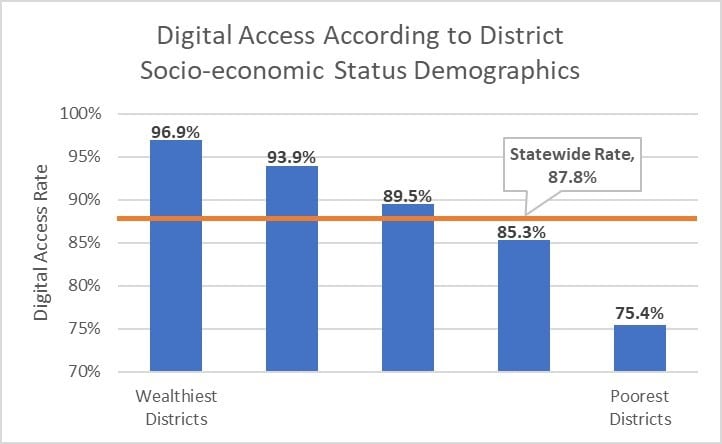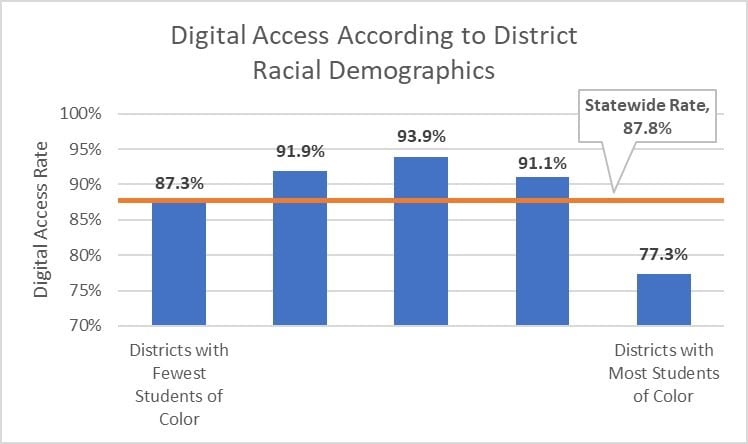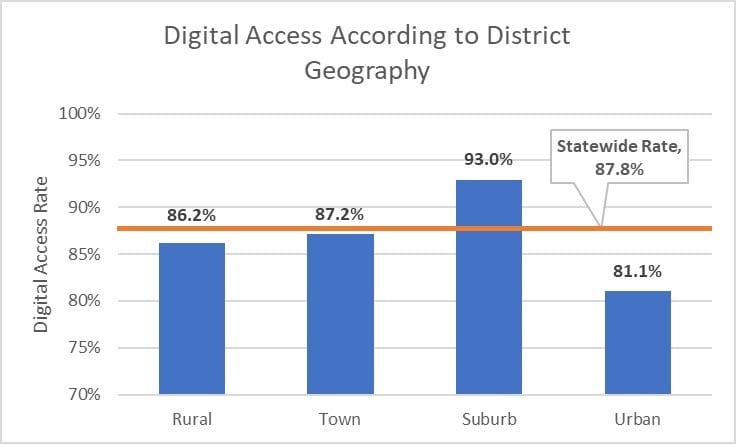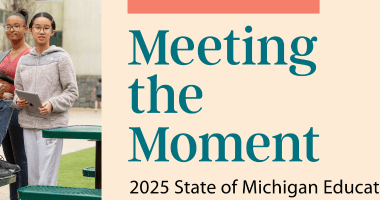Michigan’s Digital Divide
This is the second in a periodic series examining the six recommendations in our recent 2020 State of Michigan Education Report, A Marshall Plan: Reimagining Michigan Public Education. Today, we’re exploring the recommendation on quality virtual instruction and access.
Read more on Michigan’s Digital Divide and view the technical appendix.
For hundreds of thousands of children in the state of Michigan, participating in online virtual instruction could be a significant challenge due to a lack of digital access in their household, according to new analyses from The Education Trust-Midwest. And it is the most vulnerable groups of students that are most likely to lack digital access, putting them at a major disadvantage as many districts across the state anticipate distance learning to be at least a component of their instructional plan this school year.
While it’s clear that virtual learning is not a substitute for high-quality, in-person instruction, all Michigan students should have the technology and resources they need to access this form of instruction should it be necessary due to public health concerns.
The digital divide is just one of the many long-standing equity issues that have been magnified during the pandemic, which has disproportionately impacted many children in the United States, especially Black and brown children, children from low-income backgrounds and children from rural communities.
Before the pandemic, the millions of American children without digital access already faced challenges in accessing online resources to complete homework assignments, build digital literacy skills and continue or accelerate their learning at home. Data demonstrates that the children already facing these barriers were disproportionately students of color, students from low-income backgrounds and students in rural communities.
With the abrupt end to in-person learning during the 2019-2020 school year and rapid shift to distance learning, the impact of the digital divide on vulnerable students was heightened. Students who lacked strong internet connections and devices were unable to participate in online lessons or log on to complete their assignments, often relying on paper packets to continue their learning in the spring. According to a national survey, nearly half of high-poverty districts said they used paper packets as a primary part of remote instruction for elementary school students this spring, compared to only 18 percent of wealthy districts. For middle and high school students, 42 percent of high-poverty districts reported relying on paper packets, compared to only 9 percent of wealthy districts.
With many school districts incorporating some degree of online learning into their curriculum for the 2020-2021 school year, identifying and closing the digital divide is imperative, as is ensuring that when virtual instruction is required, it is high-quality and rigorous.
Earlier this year, The Education Trust-Midwest released an interactive map to shed light on gaps in digital access in districts across the state of Michigan. The latest analyses shed further light on the impact of the digital divide by examining digital access according to income, race and geography. Findings demonstrate that vulnerable student groups and students in Michigan’s rural and urban districts are more likely to be without digital access.
In Michigan’s poorest districts, digital access is 20 percent lower than in the wealthiest districts.

Students of color are more likely to be without digital access, a troubling finding that may exacerbate long-standing opportunity and achievement gaps. In districts with the highest rates of students of color, nearly 1 in 4 children lack digital access. This access rate is ten percentage points lower than the statewide rate.

Data also shows that the digital divide is a barrier for students in both urban and rural districts. Compared to other geographies, fewer households in urban and rural districts have access to devices and internet.

Because the long-term effects of COVID-19 and the disruptions to student learning it has caused are yet to be known, it is important to do everything possible in the coming school year to mitigate the impacts of the pandemic on Michigan students, especially the most vulnerable.
State leaders can – and should – play a leading role in improving digital access and ensuring that instruction provided virtually is rigorous and standards-aligned and that appropriate academic and socioemotional supports are available for every student, especially English learners and students with disabilities. Further disruptions to instruction and learning could have lasting impacts for students, including being less prepared for postsecondary opportunities, which could mean bearing the extra costs of remedial coursework or lower lifetime earnings.
COVID-19 continues to exacerbate systemic inequities, and Michigan’s most vulnerable students are paying the price. To realize a more equitable education system when we emerge from this health crisis, systemic inequities, including the digital divide and gaps in opportunity and achievement, must be addressed. This requires action at all levels – including Congress, state legislators, district administrators and classroom educators. Together, we can create a system of public education that meets the needs of every learner, regardless of where learning happens.










